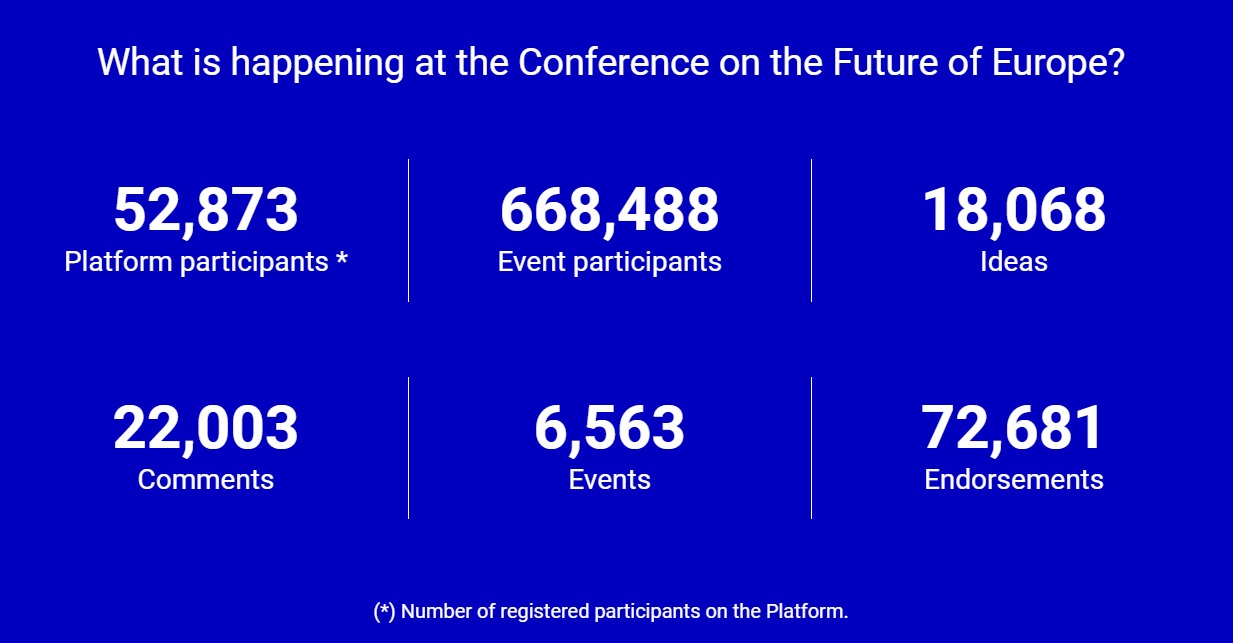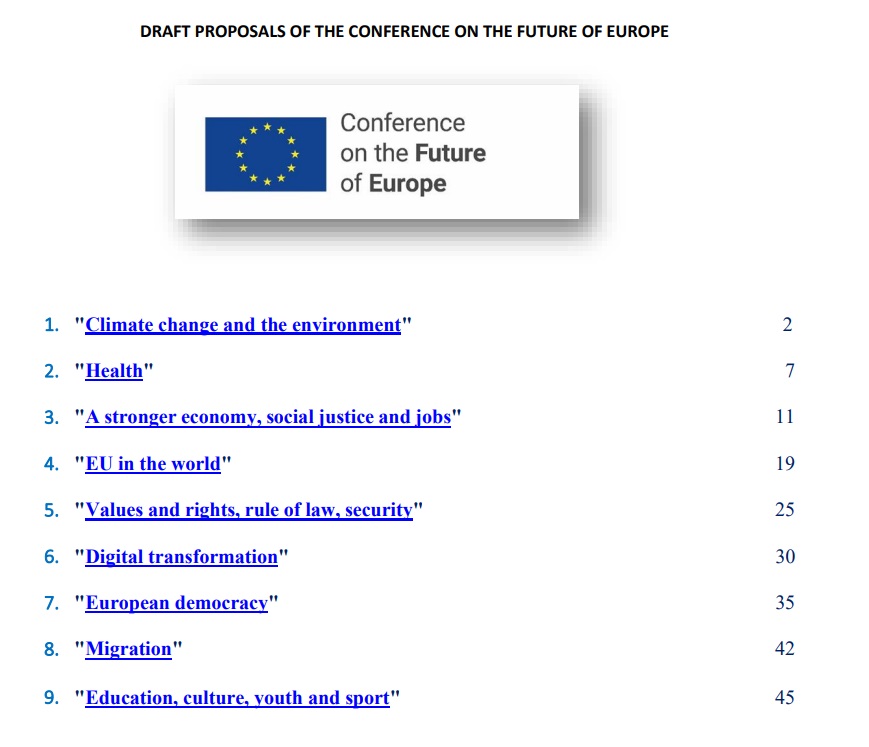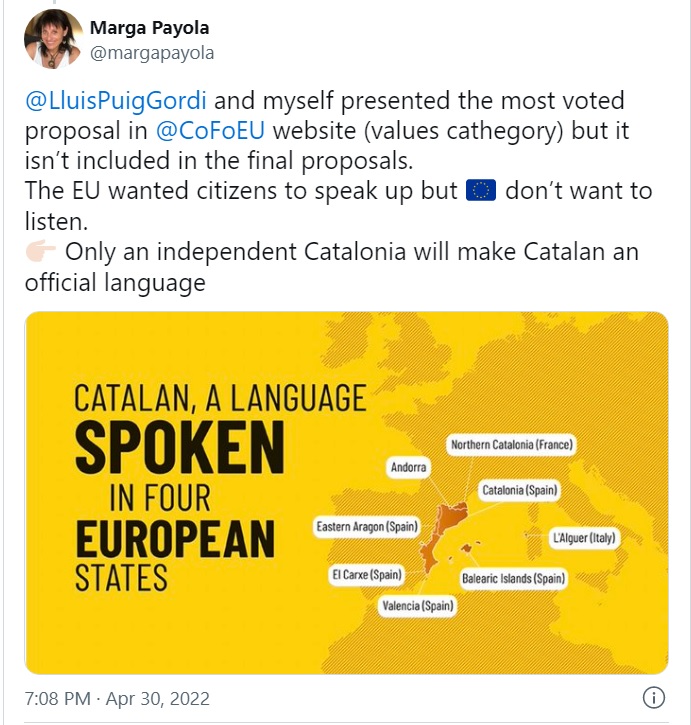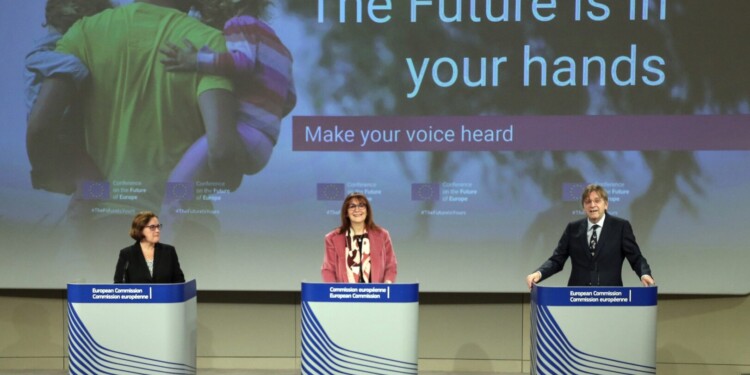Since its historic beginning in Rome, the European Union has always been seen as suffering from a democratic deficit, and the idea of a Conference on the Future of Europe proposed by the European Commission and the European Parliament at the end of 2019 was meant as a way to remedy that deficit once and for all.
On 19 April 2021, the multilingual digital platform of the Conference was launched and the real work started. The Conference thus functioned one full year and is now set to present its final recommendations on May 9, a symbolic date since it’s Europe Day. The Conference brought together some 700,000 participants and produced thousands of ideas and recommendations:

This is a much better result than what had been foreseen just a few months ago, in November 2021 when the Conference was seen as “faltering” due to lack of participation. At that point, only 7,115 ideas and 2,079 events were inserted on the platform. The “lukewarm participation” was attributed to the lack of political investment on the Conference by political representatives and governments throughout Europe. And of course, Covid lockdown measures didn’t help.
But positive change clearly came in the last six months. The aims of the Conference, from the start, had been ambitions: review the medium to long term future of the European Union and what reforms should be made; involve as many citizens as possible, including young people; and get all three institutions that guide the EU – the European Commission (its executive arm), the European Council (its political junta of 27 national leaders) and the European Parliament – to work together and organize it.
Italy was one of the staunchest supporters of the idea and already in 2019 it had developed a “non-paper” to map out its position, spelling out what it wanted to see as the outcome of such an exercise, arguing that “the real added value of the conference would be promoting a Europe-wide integrated debate on cross-cutting issues.”
In the event, that is precisely what happened: a European-wide debate on issues of direct relevance to all EU citizens.
The Conference’s final Plenary Meeting took place last week on April 20 and 30 at the European Parliament in Strasbourg, reaching a consensus on its draft proposals. The draft now contains 325 proposals to achieve 49 objectives identified across 9 themes, based on 178 recommendations from the European Citizens’ Panels, input from the National Panels and events, and 43 734 contributions on 16 274 ideas recorded on the multilingual digital platform.
An impressive result, compressing so many ideas in just 49 pages.

There is no space here to go over every proposal but overall, they are remarkably coherent and provide solid guidance. Perhaps more strikingly, the recommendations make sense even in highly complex and sensitive areas like migration policies where citizen points of view are highly divergent: They range from advocating full integration of all migrants regardless of origin to limiting integration to those coming from “developed democracies” to pushing back on the idea of opening the doors too wide out of a fear that unmanageable numbers of migrants would “strain capacity”.
What is unique about this Conference: Collecting citizen ideas and policy suggestions through digital means
There is no question that the Conference by bringing together citizens and political representatives marks a special moment in democracy, turning it into a more “participatory” or “deliberative” democracy: European citizens got the opportunity to express their views in the course of a whole year. This is in stark contrast to our standard democratic systems whereby citizens express their opinions only occasionally in votes for elections – that return only every 4 or 5 years – or votes for referendums that are organized rarely and only ad hoc.
Here, European citizens from all walks of life were called upon to freely provide their views on a digital platform that has been made easily accessible for a whole year (and is still open now – but hurry, the process will end shortly):
However, from the start, there was a fear of shaking the EU building too hard, wrenching it from its foundations. Even the Italian non-paper I mentioned above duly noted that while “the Conference should not shy away from discussing targeted but symbolically important innovations to the EU institutional setup”, it cautiously added that “it would be probably premature, at this stage, to envisage a major overhaul of the European architecture.”
So are we going to get a “major overhaul of the European architecture”? Too soon to say, but certainly, big changes could happen: the Conference recommendations are wide-ranging and each asked for change – including a loud demand to call for a “convention” to review and reform the founding EU treaties. Petros Fassoulas, Secretary-General of the European Movement International, told the plenary of the Conference that he thought this was essential:
Conference follow-up: Hopes for change are high
The three co-chairs of the Conference – each representing one of the main EU institutions – were sanguine about follow-up in the joint press conference they held last Saturday (see the video, click here). In particular, Guy Verhofstadt, MEP, said the Conference could be “a template for the future of democracy to get politicians and citizens working together” and Dubavka Suica, Vice-President of the European Commission in charge of Democracy and Demography noted that this conference was unique in that it forced all three EU institutions to work together.
Indeed, it’s a well-known fact that the three EU institutions rarely work well together.
The EU Commission, as the EU executive arm, naturally resents oversight from the European Parliament and the European Council, and feelings of resentment work both ways among all three. The European Parliament feels it hasn’t enough of a voice in budgeting and programming and the European Council systematically pushes back against the concept of European sovereignty since it is composed of 27 national leaders, each attached to his or her own national interests.
Perhaps the surprise is that EU institutions can work together at all, and the unity of purpose shown recently in the face of the Ukraine crisis has taken everyone by surprise, probably Putin more than anyone else, as he surely must have expected the EU to sink into paralyzing confusion.
European Parliament Members ready to push for Treaty revision to give more powers to the Parliament
Following the presentations of the Conference draft recommendations, representatives of the four institutional components of the Conference (Parliament, Council, Commission, and national parliaments) approved the proposals by consensus. During his speech on behalf of Parliament’s delegation, the Co-Chair of the Conference Guy Verhofstadt confirmed that the political groups will table a resolution during Parliament’s 2-5 May plenary session to call for a revision of the Treaties.
Commenting that this Conference has made him realise the importance of participatory mechanisms complementary to representative democracy, he stated that MEPs must fight hard to ensure that the Conference’s proposals will be turned into the reforms that the EU needs.
MEPs reacting to the Conference recommendations specifically highlighted giving the European Parliament the right to budgetary initiative, the right to scrutinize the executive through a committee of inquiry, and fully-fledged competence in the field of foreign and security policy. These are key demands. In addition, MEPs also called for schools to include education for children in European values, democracy and history, and how the EU functions.
These are big demands, and so far, the EU Parliament is the only EU institution that has paid attention to these recommendations – or at least some members, certainly not all of them, not yet.
Expect pushback from Euro-skeptics who clearly take the position that a conference to discuss the “future of Europe” cannot make credible recommendations if it does not include people that believe Europe should not exist at all.
That point was most recently made by a notorious Euro-skeptic Swedish MEP, arguing that the idea of a federalized Europe is an “elite” view, implying it’s therefore despicable – and conveniently forgetting that his own attachment to 19th-century national sovereignty views is equally “elitist”:
— Charlie Weimers MEP
(@weimers) April 30, 2022
One wonders why Weimers thinks a Conference that is specifically tasked with discussing the “future of Europe” should also consider that Europe has no future.
But conservative populist politicians are not the only ones who protest. National minority groups are also vocal and how to deal with them is likely to remain a continuing problem for the European Union. For example, Catalans who continue their fight against Spain’s own firm grip on the concept of its own sovereignty:

European Commission reacts – European Council is awaited
As I write, so far the only other EU institution that has reacted to the recommendations is the European Commission with the following tweet:
The proposals include, among others:
European minimum wages
Guaranteed access to healthcare
Accomplishing the green transition
EP: Michel Christen pic.twitter.com/PDA3uNYLia
— European Commission
(@EU_Commission) April 30, 2022
This makes it clear what was of particular interest to the EU Commission that is, unsurprisingly, seeking confirmation of three of its major policy directions:
(1) establishing European minimum wages;
(2) guaranteed access to healthcare;
(3) completing the “green transition”.
Not a word about a convention or reviewing the EU treaties.
The last word however will no doubt come from the European Council, the EU governing “head” where all 27 EU leaders have an equal vote – a very unfortunate situation that often leads the EU to political paralysis, or to make decisions only on relatively unimportant matters, the kind that elicit the broadest consensus precisely because they do not implicate national interests.
The political game at the level of the Council is, of course, more complicated than that, with big countries playing an outsize role, especially when they get together as Germany and France have so often done, taking advantage of their “special friendship” to push for mutually-agreeable decisions.
So chances are high that the recommendations of the Future of Europe Conference will be shelved and forgotten unless pressure on the Council – and the 27 national leaders – can be maintained by both the European Parliament and the Commission, and of course, also directly by citizens everywhere across Europe.
Eventually, change can happen if, and only if, the three major EU institutions that guide the European Union will listen and take the recommendations on board and act on them. And if all of us, European citizens, join in the debate and put pressure on EU institutions for change.
Editor’s Note: The opinions expressed here by Impakter.com columnists are their own, not those of Impakter.com — In the Featured Photo: Conference co-chairs Source: Euractiv











